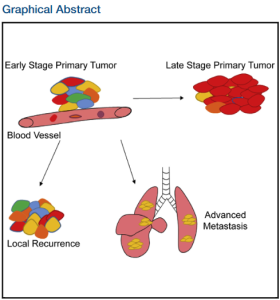Metastatic cancer is what is often referred to as stage 4 cancer, and describes the development of cancer where the cancerous cells spread to other organs in the body. This process is called metastasis. Metastasis is an important occurrence that often determines the fatality of cancer for many people, making it a significant point of research worldwide. Metastasis is considered a multi-step cascade involving the following key processes (Lambert et al., 2017):
- Intravasation: Cancerous cells leave the primary site (original tumor) and enter the bloodstream
- Survival in circulation: The cells survive while moving through the body in the bloodstream
- Extravasation: The cells manage to exit the bloodstream and breach the extracellular matrix of other organs
- Engraftment: Cancer cells adhere to the tissues of foreign organs
- Metastatic Colonization: Now-metastatic cells proliferate and form cancerous lesions in the foreign organs creating secondary tumors
Y. J. Tang et al., 2019 with the Alman Lab at Duke conducted a study with undifferentiated pleomorphic sarcoma (UPS) in mouse models that indicated that although a variety of clones (i.e. cancer cell types) completed the intravasation and survival in circulation steps of metastasis, only a single clonal variant was responsible for the development of secondary lesions in the lung. The term metastasis-initiating cells (MIC) refers to these cells that can survive and form secondary lesions. The survival of solely MICs means there is something, some physical or chemical wall, a filter of sorts, that weeds out the rest of the cells such that only a select type can survive and proliferate in the lung.
 Graphical Abstract from Y.J. Tang et al., 2019 where you can see that there is a heterogenous mix of cell types in the primary tumor, but a single type in advanced metastasis.
Graphical Abstract from Y.J. Tang et al., 2019 where you can see that there is a heterogenous mix of cell types in the primary tumor, but a single type in advanced metastasis.
This summer I am working to investigate what this filter might be. Using a microfluidic device, or a small device that has microchannels and chambers which cells can be seeded into, I will be studying the physical properties of MICs. One of the first things I will be considering is the process of extravasation, where MICs must travel through microbial spaces in the extracellular matrix. Using a microfluidic device with varying dimensions of microchannels, hopefully, I might be able to identify both the deformability of UPS MICs (how much they can deform to squeeze through a small gap) and if only MICs are able to deform to get through certain size channel. This may demonstrate a potential point in metastasis where the filter may lie.
I found this finding and point of research to be a cool parallel to the Great Filter theory, a postulate formulated by Robin Hanson as a potential resolution to the Fermi Paradox. Although the Fermi paradox itself doesn’t exactly resemble metastasis, the Great Filter theory suggests that there is some point in the general life cycle of an alien civilization as it progresses from low intelligence and advancement to high intelligence and advancement where there is a filter that results in civilizations getting wiped out. Just like how in metastasis there are numerous cell types that follow the metastatic process, but there is a filter somewhere that weeds out the rest and allows only some to slip through the cracks.
